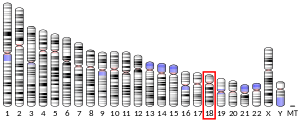MEP1B
Meprin A subunit beta is a protein that in humans is encoded by the MEP1B gene.[5][6]
Meprins are multidomain zinc metalloproteases that are highly expressed in mammalian kidney and intestinal brush border membranes and in leukocytes and certain cancer cells. Mature meprins are oligomers of evolutionarily related, separately encoded alpha and/or beta subunits. Homooligomers of meprin-alpha (MEP1A; MIM 600388) are secreted; oligomers containing meprin-beta are associated with the plasma membrane. Substrates include bioactive peptides and extracellular matrix proteins. See MIM 600388 for further information on meprins.[supplied by OMIM][6]
References
- GRCh38: Ensembl release 89: ENSG00000141434 - Ensembl, May 2017
- GRCm38: Ensembl release 89: ENSMUSG00000024313 - Ensembl, May 2017
- "Human PubMed Reference:". National Center for Biotechnology Information, U.S. National Library of Medicine.
- "Mouse PubMed Reference:". National Center for Biotechnology Information, U.S. National Library of Medicine.
- Bond JS, Rojas K, Overhauser J, Zoghbi HY, Jiang W (Jul 1995). "The structural genes, MEP1A and MEP1B, for the alpha and beta subunits of the metalloendopeptidase meprin map to human chromosomes 6p and 18q, respectively". Genomics. 25 (1): 300–3. doi:10.1016/0888-7543(95)80142-9. PMID 7774936.
- "Entrez Gene: MEP1B meprin A, beta".
Further reading
- Yamaguchi T, Fukase M, Sugimoto T, et al. (1995). "Purification of meprin from human kidney and its role in parathyroid hormone degradation". Biol. Chem. Hoppe-Seyler. 375 (12): 821–4. PMID 7710697.
- Kaushal GP, Walker PD, Shah SV (1994). "An old enzyme with a new function: purification and characterization of a distinct matrix-degrading metalloproteinase in rat kidney cortex and its identification as meprin". J. Cell Biol. 126 (5): 1319–27. doi:10.1083/jcb.126.5.1319. PMC 2120165. PMID 8063866.
- Dumermuth E, Eldering JA, Grünberg J, et al. (1994). "Cloning of the PABA peptide hydrolase alpha subunit (PPH alpha) from human small intestine and its expression in COS-1 cells". FEBS Lett. 335 (3): 367–75. doi:10.1016/0014-5793(93)80421-P. PMID 8262185.
- Bankus JM, Bond JS (1996). "Expression and distribution of meprin protease subunits in mouse intestine". Arch. Biochem. Biophys. 331 (1): 87–94. doi:10.1006/abbi.1996.0286. PMID 8660687.
- Chevallier S, Ahn J, Boileau G, Crine P (1996). "Identification of the cysteine residues implicated in the formation of alpha 2 and alpha/beta dimers of rat meprin". Biochem. J. 317 (3): 731–8. PMC 1217546. PMID 8760356.
- Chestukhin A, Muradov K, Litovchick L, Shaltiel S (1997). "The cleavage of protein kinase A by the kinase-splitting membranal proteinase is reproduced by meprin beta". J. Biol. Chem. 271 (47): 30272–80. doi:10.1074/jbc.271.47.30272. PMID 8939981.
- Eldering JA, Grünberg J, Hahn D, et al. (1997). "Polarised expression of human intestinal N-benzoyl-L-tyrosyl-p-aminobenzoic acid hydrolase (human meprin) alpha and beta subunits in Madin-Darby canine kidney cells". Eur. J. Biochem. 247 (3): 920–32. doi:10.1111/j.1432-1033.1997.00920.x. PMID 9288916.
- Lottaz D, Hahn D, Müller S, et al. (1999). "Secretion of human meprin from intestinal epithelial cells depends on differential expression of the alpha and beta subunits". Eur. J. Biochem. 259 (1–2): 496–504. doi:10.1046/j.1432-1327.1999.00071.x. PMID 9914532.
- Kumar JM, Bond JS (2001). "Developmental expression of meprin metalloprotease subunits in ICR and C3H/He mouse kidney and intestine in the embryo, postnatally and after weaning". Biochim. Biophys. Acta. 1518 (1–2): 106–14. doi:10.1016/S0167-4781(01)00188-9. PMID 11267665.
- Bertenshaw GP, Turk BE, Hubbard SJ, et al. (2001). "Marked differences between metalloproteases meprin A and B in substrate and peptide bond specificity". J. Biol. Chem. 276 (16): 13248–55. doi:10.1074/jbc.M011414200. PMID 11278902.
- Litovchick L, Friedmann E, Shaltiel S (2002). "A selective interaction between OS-9 and the carboxyl-terminal tail of meprin beta". J. Biol. Chem. 277 (37): 34413–23. doi:10.1074/jbc.M203986200. PMID 12093806.
- Leuenberger B, Hahn D, Pischitzis A, et al. (2003). "Human meprin beta: O-linked glycans in the intervening region of the type I membrane protein protect the C-terminal region from proteolytic cleavage and diminish its secretion". Biochem. J. 369 (Pt 3): 659–65. doi:10.1042/BJ20021398. PMC 1223113. PMID 12387727.
- Bertenshaw GP, Norcum MT, Bond JS (2003). "Structure of homo- and hetero-oligomeric meprin metalloproteases. Dimers, tetramers, and high molecular mass multimers". J. Biol. Chem. 278 (4): 2522–32. doi:10.1074/jbc.M208808200. PMID 12399461.
- Norman LP, Jiang W, Han X, et al. (2003). "Targeted disruption of the meprin beta gene in mice leads to underrepresentation of knockout mice and changes in renal gene expression profiles". Mol. Cell. Biol. 23 (4): 1221–30. doi:10.1128/MCB.23.4.1221-1230.2003. PMC 141138. PMID 12556482.
- Hahn D, Pischitzis A, Roesmann S, et al. (2003). "Phorbol 12-myristate 13-acetate-induced ectodomain shedding and phosphorylation of the human meprinbeta metalloprotease". J. Biol. Chem. 278 (44): 42829–39. doi:10.1074/jbc.M211169200. PMID 12941954.
- Herzog C, Kaushal GP, Haun RS (2005). "Generation of biologically active interleukin-1beta by meprin B.". Cytokine. 31 (5): 394–403. doi:10.1016/j.cyto.2005.06.012. PMID 16095909.
- Becker-Pauly C, Höwel M, Walker T, et al. (2007). "The alpha and beta subunits of the metalloprotease meprin are expressed in separate layers of human epidermis, revealing different functions in keratinocyte proliferation and differentiation". J. Invest. Dermatol. 127 (5): 1115–25. doi:10.1038/sj.jid.5700675. PMID 17195012.
This article is issued from Wikipedia. The text is licensed under Creative Commons - Attribution - Sharealike. Additional terms may apply for the media files.




